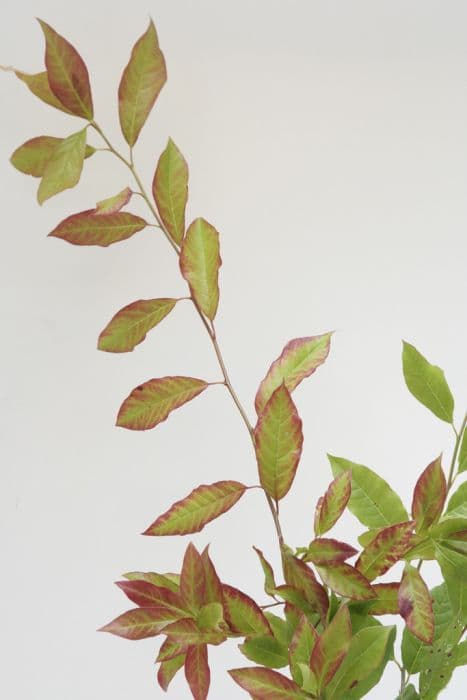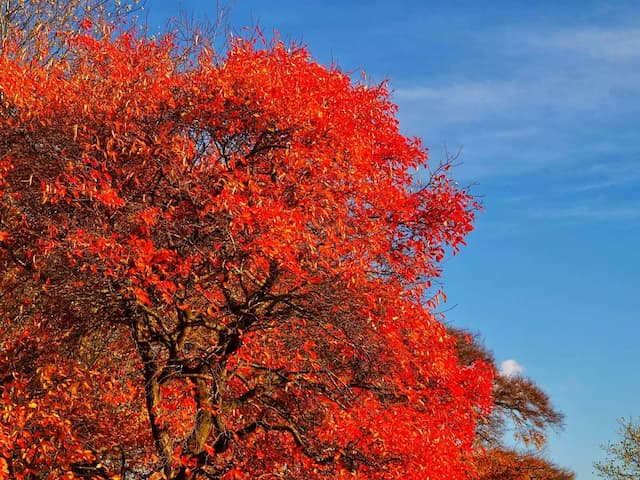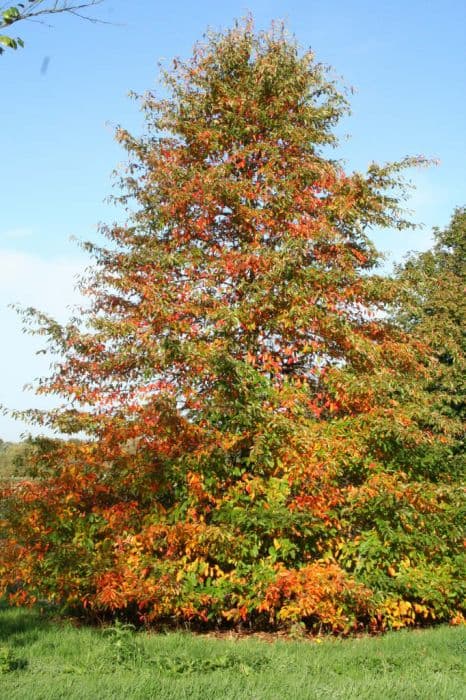Chinese Tupelo Nyssa sinensis 'Jim Russell'

ABOUT
Nyssa sinensis 'Jim Russell' is a plant known for its attractive foliage and seasonal color changes. This deciduous tree showcases elliptical leaves with a slightly wavy edge. The leaves emerge in a fresh green hue during the spring and mature to a dark green as the season progresses. One of the most striking features of this plant is the transformation of its foliage in the fall; the leaves turn to varying shades of orange, red, and purple, providing a striking display of autumn color. The bark of the tree is also notable for its textured appearance, adding interest even in winter months after the leaves have dropped. Flowering in the spring, 'Jim Russell' produces small, inconspicuous flowers that may go unnoticed against the backdrop of emerging leaves. These are followed by fruit that is typically attractive to wildlife. The tree has a pyramidal to slightly rounded canopy, giving it a robust and elegant appearance. It is known for its strong branch structure, which adds to its ornamental value throughout the year.
About this plant
 Names
NamesFamily
Nyssaceae
Synonyms
Chinese Tupelo, Jim Russell Black Gum
Common names
Nyssa sinensis 'Jim Russell'.
 Toxicity
ToxicityTo humans
The Chinese tupelo, as Nyssa sinensis 'Jim Russell' is commonly known, is not typically recognized for having toxic properties to humans. There are no well-documented cases or widely-known reports of poisoning from this tree's ingestion that suggest a risk to human health. Therefore, there are no specific symptoms of poisoning associated with the Chinese tupelo for humans.
To pets
Similarly, the Chinese tupelo is not known to be toxic to pets. It is not listed among commonly poisonous plants for animals such as dogs and cats. There are no reported symptoms of poisoning, as the ingestion of parts of this plant is unlikely to cause any ill effects. As always, it is best practice to monitor pets and prevent them from ingesting plants, since individual animals might have unexpected reactions.
 Characteristics
CharacteristicsLife cycle
Perennials
Foliage type
Deciduous
Color of leaves
Green
Height
20-30 feet (6-9 meters)
Spread
15-20 feet (4.5-6 meters)
Plant type
Tree
Hardiness zones
6
Native area
China
Benefits
 General Benefits
General Benefits- Ornamental Value: Nyssa sinensis 'Jim Russell', commonly known as the Chinese tupelo, has an attractive shape and foliage that brings ornamental value to landscapes.
- Seasonal Interest: It displays vibrant fall colors that add seasonal interest to gardens.
- Wildlife Habitat: Provides food and shelter for various wildlife, including birds and small mammals.
- Shade Provider: Mature trees can offer a considerable amount of shade, making outdoor spaces more comfortable.
- Drought Tolerance: Once established, it has a good level of drought tolerance, reducing the need for frequent watering.
- Low Maintenance: Requires minimal pruning and is generally low maintenance, making it a good choice for gardeners of all skill levels.
- Adaptability: Can adapt to a variety of soil types, though it prefers moist, well-drained soils.
- Resistant to Pests: Shows resistance to many common pests, reducing the need for chemical treatments.
 Medical Properties
Medical PropertiesThis plant is not used for medical purposes.
 Air-purifying Qualities
Air-purifying QualitiesThis plant is not specifically known for air purifying qualities.
 Other Uses
Other Uses- Photography: Chinese tupelo's vibrant autumn foliage provides a compelling backdrop for seasonal photography.
- Beekeeping: The tree can serve as a source of nectar for bees during its flowering season.
- Furniture: The wood of Chinese tupelo is strong and can be used for making furniture, although it's not commonly used for this purpose.
- Handicrafts: The wood's fine grain can be used for carving and crafting small decorative items.
- Dye production: The bark and leaves may be used to produce natural dyes for textiles, although this application is not well documented.
- Sound barriers: When planted in dense rows, Chinese tupelo can help reduce noise pollution due to its thick foliage.
- Culinary experiments: Though not a typical use, leaves of certain Nyssa species may be explored for their potential use in unique culinary preparations.
- Educational tool: Chinese tupelo can be used in botany and horticulture education to teach about plant identification and autumn foliage changes.
- Art inspiration: The tree's change in leaf color from green to orange or red can inspire artists for color palettes and themes in their work.
- Holiday decorations: Branches and leaves, especially during the fall, can be used to create natural and eco-friendly holiday decor.
Interesting Facts
 Feng Shui
Feng ShuiThe Chinese tupelo is not used in Feng Shui practice.
 Zodiac Sign Compitability
Zodiac Sign CompitabilityThe Chinese tupelo is not used in astrology practice.
 Plant Symbolism
Plant Symbolism- Resilience: Nyssa sinensis, commonly known as Chinese Tupelo, often symbolizes resilience because of its ability to thrive in various soil conditions, including wet areas where other trees may struggle to grow.
- Adaptability: Chinese Tupelo embodies adaptability, as it can adjust to different environments, reflecting a flexible approach to life's challenges.
- Change: With its striking autumn foliage that changes color, the Chinese Tupelo often represents change and transformation, reminding us of the cyclical nature of life.
- Longevity: As a tree known for its long life, the Chinese Tupelo symbolizes endurance and the passage of time, signifying a long and lasting impact.
 Water
WaterThe Chinese tupelo should be watered deeply and thoroughly, so the soil is moist but not soggy, as it prefers consistent moisture. During the growing season, provide approximately 1 to 1.5 inches of water weekly, being mindful to adjust this based on rainfall, with less frequent watering during the dormant winter months. Always check the top few inches of soil for dryness before watering again. Overwatering or allowing the plant to sit in water can lead to root rot, so ensure good drainage. It is beneficial to use mulch to help retain soil moisture and reduce watering frequency.
 Light
LightChinese tupelo flourishes best in full sun to partial shade. Ideally, it should receive at least 4 to 6 hours of direct sunlight each day. An east-facing or west-facing location can be suitable for providing the right lighting conditions, ensuring that the plant gets enough light to thrive without being exposed to harsh midday sun that might stress the plant in very hot climates.
 Temperature
TemperatureFor the Chinese tupelo, the ideal temperature range for optimal growth is between 40°F to 90°F. The plant is hardy and can withstand temperatures down to approximately 20°F. However, prolonged exposure to temperatures below freezing may damage the plant. It’s important to protect the Chinese tupelo from extreme cold or sudden temperature fluctuations, which can be harmful.
 Pruning
PruningPrune the Chinese tupelo to shape it, remove any dead or damaged branches, and to encourage healthy growth. The best time for pruning is in late winter or early spring before new leaves emerge. Pruning should be done as needed, usually not more than once per year unless you are removing broken branches which can be done at any time to maintain the health of the plant.
 Cleaning
CleaningAs needed
 Soil
SoilChinese Tupelo prefers moist, well-drained acidic soil with a pH between 5.5 and 6.5. A mix of loam, sand, and organic matter like peat or leaf mold is ideal to ensure good drainage and the right nutrient balance.
 Repotting
RepottingChinese Tupelo typically does not need frequent repotting; once every 2 to 3 years is sufficient. Younger trees may require more frequent repotting as they grow more rapidly.
 Humidity & Misting
Humidity & MistingChinese Tupelo thrives in moderate to high humidity levels, ideally between 40% and 60%. They do not tolerate dry air well, so maintaining consistent humidity is necessary for their health.
 Suitable locations
Suitable locationsIndoor
Place in bright, indirect light and keep soil consistently moist.
Outdoor
Plant in moist, acidic soil in a sunny or partly shaded spot.
Hardiness zone
6-9 USDA.
 Life cycle
Life cycleThe life of Chinese tupelo 'Jim Russell' begins with seed germination, where favorable conditions of warmth and moisture allow the seed to sprout and a root system to establish. After germination, the seedling emerges and begins vegetative growth, developing stems, leaves, and a more extensive root system through the nutrient uptake from the soil. As the Chinese tupelo matures, it enters the sapling phase where it experiences rapid growth and begins to develop its characteristic shape and form. Upon reaching maturity, the Chinese tupelo is capable of flowering, typically in spring, with flowers that are inconspicuous yet essential for the reproductive process, followed by the production of fruits, which are bluish-black drupes that mature in late summer to fall. The tree then enters a period of senescence where growth slows, and it may begin to show signs of aging, such as reduced foliage and branch dieback. Finally, the end of the Chinese tupelo's life cycle occurs when the plant dies, either due to environmental factors, disease, or old age, at which point it decomposes and returns nutrients to the soil, completing the cycle.
 Propogation
PropogationPropogation time
Spring-Early Summer
The Chinese tupelo 'Jim Russell', typically propagated by seed, is best sown during the autumn. To propagate by seed, one should collect the fruit as soon as it ripens, clean the seeds from the pulp, and sow them in a cold frame or seedbed outdoors as soon as possible. Seeds need exposure to cold temperatures for a period to break dormancy, a process known as stratification. This period of cold stratification simulates natural winter conditions, allowing the seeds to germinate properly in spring. Seedlings are usually ready to be transplanted into their permanent locations the following autumn.




